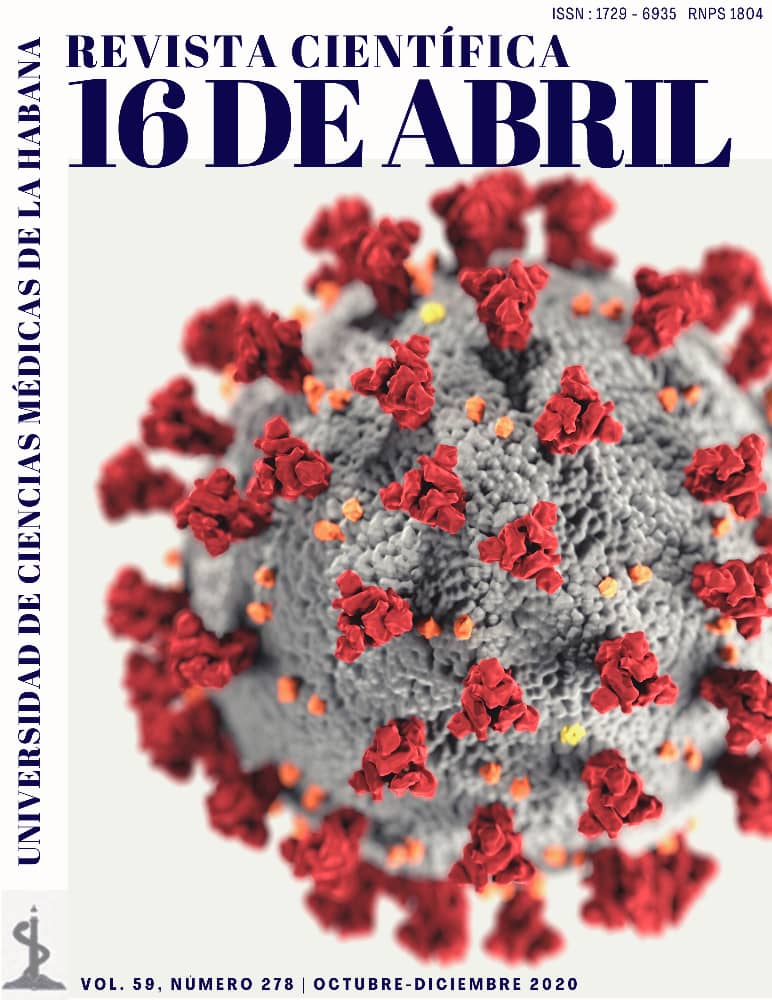Sexual dysfunctions in middle-aged women with menstrual disorders
Keywords:
Menstrual disorders, climacteric, menopauseAbstract
Introduction: Among the main reasons for consultation in middle-aged women are menstrual disorders, which are very often associated with sexual dysfunction as part of the symptoms of climacteric syndrome. Objective: to describe the main sexual dysfunctions of the middle-aged women who came for menstrual disorders to the multidisciplinary climacteric and menopause consultation. Material and methods: an observational, descriptive and cross-sectional study was carried out at the “Ramón González Coro” Gyneco-obstetric Hospital during the years 2014-2019. The sample consisted of 897 women. The data was processed digitally, using descriptive statistics. The results were obtained by elementary calculation methods and for their collation, they were ordered and tabulated, for which Microsoft Word and Microsft Excel 2010 were used. Results: in 309 of the women studied, hyperpolymenorrhea was present, which represents 34.5%, with a decrease in sexual desire prevailing in 758 for 84.5% and dyspareunia in 412 for 45.9%. With decreased sexual desire, the predominant menstrual disorders were hyperpolymenorrhea in 131 patients for 17.8% and metrorrhagia in 93 for 12.3% for this group.Conclusions: in the women studied, the decrease in sexual desire predominated, followed by dyspareunia and lastly, orgasmic dysfunction as the main sexual dysfunctions. Disorders in the intensity of sexual desire were associated with hyperpolymenorrhea and bleeding, dyspareunia with amenorrhea, and orgasmic dysfunction was unrelated. [Separate in results (put the most relevant with absolute and percentage values), then conclusions]
References
2. Navarro D.:”Climaterio y Menopausia. De médica a mujer “.Editorial Cientifico Técnica. 2006; 2(1): p: 32-37.
3. Navarro D.”Diabetes Mellitus, Menopausia y Osteoporosis”. Editorial Cientifico Técnica. 2007: 4(2): p: 7.
4. Corral A., Castañeda IE., Barzaga M., Santana MC.: “Determinantes sociales en la diferencial de mortalidad entre mujeres y hombres en Cuba.” Revista Cubana de Salud Pública. [internet] 2010 [citado 13 Mayo 2020]; 36(1):66‐77. Disponible en: http://scielo.sld.cu/scielo.php?script=sci_arttext&pid=S086434662010000100008.
5 . Artiles L., Navarro D., Manzano B.:”Climaterio y Menopausia Un enfoque desde lo social”. Ciudad Habana. Editorial Científico Técnica. [internet] 2007 [citado 13 Mayo 2020]; 2(1): 28-31. Disponible en: https://www.scienceopen.com/document?vid=68f5111c-9433-4108-bfff-4816009940f5
6. Anuario Estadístico de Salud 2019 Ministerio de Salud Pública. Dirección Nacional de Registros Médicos y Estadísticas de Salud. La Habana, 2020.
7. Delgado L., Manzano B.R., Navarro D., Roque M.C. “Caracterización de los trastornos menstruales y el sangrado posmenopáusico en mujeres de edad mediana”. Rev. Panorama Cuba y Salud. [internet] 2010 [citado 13 Mayo 2020]; 5 (1):37-43. Disponible en: https://www.redalyc.org/pdf/4773/477348940005.pdf
8. Herrera V.R.; Torres R.M.:” Algunos componentes del estado de salud de la mujer cubana”. Rev Cubana Salud Pública. [internet] 2009 [citado 13 Mayo 2020]; 35 (1):4,5. Disponible en: http://scielo.sld.cu/scielo.php?script=sci_arttext&pid=S086434662009000100009
9. Castañeda I. E.:” Reflexiones teóricas sobre las diferencias en salud atribuibles al género”. Rev Cubana Salud Pública. [internet] 2007 [citado 16 Mayo 2020]; 33(2): p: 4-10. Disponible en: http://scielo.sld.cu/scielo.php?script=sci_arttext&pid=S086434662007000200011
10. Hale G.E., Manconi F., Luscombe G., Fraser I.S.:” Quantitative measurements of menstrual blood loss in ovulatory and anovulatory cycles in middle- and late-reproductive age and the menopausal transition”.Obstet Gynecol. [internet] 2012 [citado 13 Mayo 2020]; 115(1):249-256. Disponible en: https://europepmc.org/article/med/20093896
11. Burger HG.:” Unpredictable endocrinology of the menopause transition: clinical, diagnostic and management implications”. Menopause Int. 2013; 17(4):153-4.
12. Pitkin J.: “Dysfunctional uterine bleeding”. BMJ. [internet] 2007 [citado 13 Mayo 2020]; 334(7603): 1110–1111. Disponible en: https://www.ncbi.nlm.nih.gov/m/pubmed/17525454
13. Chen E.C., Danis P.G., Tweed E. :”Clinical inquiries. Menstrual disturbances in perimenopausal women: what's best?” J Fam Pract. [internet] 2009 [citado 13 Mayo 2020]; 58(6): 3. Disponible en: https://www.ncbi.nlm.nih.gov/m/pubmed/19508841
14. Jiménez M. C., Enríquez B., Puentes E. M.:”Comportamiento y tratamiento de los trastornos sexuales en el climaterio”. Revista Cubana de Obstetricia y Ginecología. [internet] 2010 [citado 13 Mayo 2020]; 36(2):160-172. Disponible en: http://scielo.sld.cu/scielo.php?script=sci_arttext&pid=S0138600X2010000200014
15. World Association for Sexual Health. Salud Sexual para el nuevo Milenio.Declaración y documento técnico. [internet] 2008 [citado 16 Mayo 2020] Disponible en: https://worldsexualhealth.net/wp-content/uploads/2013/08/salud-sexual-para-el-milenio.pdf
16. Capote M. I., Segredo A. M., Gómez O.: “Satisfacción de mujeres en etapa climatérica en Brisas del Golfo, República Bolivariana de Venezuela (2005-2007)”. Revista Cubana de Medicina General Integral. [internet] 2012 [citado 13 Mayo 2020]; 28(1):114-122. Disponible en: http://scielo.sld.cu/scielo.php?script=sci_arttext&pid=S086421252012000100014
17. Greenblum C. A., Rowe M.A., Neff D.F., Greenblum J.S.: “Midlife women: symptoms associated with menopausal transition and early postmenopause and quality of life.” Menopause. [internet] 2013 [citado 13 Mayo 2020]; 20(1):22-7. Disponible en: https://pubmed.ncbi.nlm.nih.gov/22929034/
18. Santiesteban S.R.:”Atención Integral a las Mujeres Climatéricas desde el nivel Primario de Salud. Junio 2000-06” Ciudad de la Habana. [internet] 2007 (Trabajo para optar por el grado científico de Doctora en Ciencias Médicas.) Disponible en: https://core.ac.uk/download/pdf/82573725.pdf
19. Mishra G.D., Kuh D. :”Health symptoms during midlife in relation to menopausal transition: British prospective cohort study.” BMJ. [internet] 2012 [citado 13 Mayo 2020]; 8 (1): 344. Disponible en: https://www.ncbi.nlm.nih.gov/m/pubmed/22318435
20. Randolph J.F., Zheng H., Sowers M.R.: “Change in follicle-stimulating hormone and estradiol across the menopausal transition: effect of age at the final menstrual period”. J Clin Endocrinol Metab. [internet] 2011 [citado 13 Mayo 2020]; 96(3):746–754. Disponible en: https://pubmed.ncbi.nlm.nih.gov/21159842/
21. Lugones M., Valdés S., Pérez J.:”Caracterización de la mujer en la etapa del climaterio(I)” .Rev Cubana de Obstetricia y Ginecología. [internet] 2001 [citado 13 Mayo 2020]; 27(1):16-21. Disponible en: http://scielo.sld.cu/scielo.php?script=sci_arttext&pid=S0138600X2001000100003
22. Lugones B.M., Córdova A.M., Dávalos S.T.:” La salud integral de la mujer en el climaterio”. Rev Sexología y Sociedad. [internet] 2003 [citado 13 Mayo 2020]; 9(23): 28-32; 25(2):108-13. Disponible en: http://revsexologiaysociedad.sld.cu/index.php/sexologiaysociedad/article/view/265
23. Lugones B. M., Navarro D. D.:” Síndrome climatérico y algunos factores socioculturales relacionados con esta etapa”. Rev Cubana Obstet Ginecol, [internet] 2006 [citado 13 Mayo 2020]; 32(1), p.0-0. Disponible en: http://scielo.sld.cu/scielo.php?script=sci_arttext&pid=S0138600X2006000100002
24. Yanes M., Chio I.: “Intensidad del síndrome climatérico y su relación con algunos factores socioambientales”. Rev. Cubana Med Gen Integr. [internet] 2009 [citado 13 Mayo 2020]; 25 (4). Disponible en: http://scielo.sld.cu/scielo.php?script=sci_arttext&pid=S0864-21252009000400004
25. Phillip H.:”Patients' preferences in the evaluation of postmenopausal bleeding”. BJOG. [internet] 2008 [citado 16 Mayo 2020]; 115 (7):924-5. Disponible en: https://www.ncbi.nlm.nih.gov/m/pubmed/18485181
26. Blümel J., Onatra W., Sánchez H., Tserotas K., Vallejo M.S., Chedraui P.:” Sexual dysfunction in middle-aged women: a multicenter Latin American study using the Female Sexual Function Index”. Menopause. [internet] 2009 [citado 13 Mayo 2020]; 16:1139–48. Disponible en: https://pubmed.ncbi.nlm.nih.gov/19458559/
27. Kingsberg S.A.: Sexual function in middle-aged Latin American women as determined by the Female Sexual Function Index: improving global acceptance of the use of validated measures of sexual function”. Menopause. [internet] 2009 [citado 13 Mayo 2020]; 16:1089–91. Disponible en: https://www.ncbi.nlm.nih.gov/m/pubmed/19696687
28. Maserejian N.N., Shifren J., Parish S.J., Segraves R.T., Huang L., Rosen RC.: “Sexual arousal and lubrication problems in women with clinically diagnosed hypoactive sexual desire disorder: preliminary findings from the hypoactive sexual desire disorder registry for women”. J Sex Marital Ther. [internet] 2012 [citado 13 Mayo 2020]; 38(1):41-62. Disponible en: https://europepmc.org/article/med/22268981
29. Hubacher D., Chen P., Park S.:” Side effects from the copper IUD: do they decrease over time?” Contraception. [internet] 2011 [citado 13 Mayo 2020]; 79(5): 356–362. Disponible en: https://pubmed.ncbi.nlm.nih.gov/19341847/
30. García I., Navarro D.: “Influencia del entorno familiar en la mujer en etapa climatérica”. Rev. Cubana Med Gen Integr. [internet] 2011 [citado 13 Mayo 2020]; 27(2): 3-5. Disponible en: http://scielo.sld.cu/scielo.php?script=sci_arttext&pid=S086421252011000200002
31. Hubacher D., Chen P., Park S.:” Side effects from the copper IUD: do they decrease over time?” Contraception. [internet] 2011 [citado 13 Jul 2020]; 79(5): 356–362. Disponible en: https://pubmed.ncbi.nlm.nih.gov/19341847/
32. Chedraui P., Pérez-López F.R., Sánchez H., Aguirre W., Martínez N., Miranda O., et al:” Impaired quality of life among middle aged women: a multicentre Latin American study”. Maturitas. [internet] 2012 [citado 13 Jul 2020]; 61:323–9. Disponible en: https://pubmed.ncbi.nlm.nih.gov/19010618/
33. Lugones M., Valdés S., Pérez J.:”Caracterización de la mujer en la etapa del climaterio(II)” Rev Cubana Obstet Ginecol. [internet] 2001 [citado 13 Jul 2020]; 27(1):22-7. Disponible en: http://scielo.sld.cu/scielo.php?script=sci_arttext&pid=S0138600X2001000100003
34. Wright JJ, O'Connor KM Female Sexual Dysfunction. Med Clin North Am. [internet] 2015 [citado 13 Jul 2020]; 99(3):607-628. Disponible en: https://pubmed.ncbi.nlm.nih.gov/25841603/
Downloads
Published
How to Cite
Issue
Section
License
Those authors who have publications with this journal, accept the following terms:
The authors will retain their copyright and guarantee the journal the right of first publication of your work, which will be under a Creative license Commons Attribution-NonCommercial-ShareAlike 4.0 International . (CC BY-NC-SA 4.0).
The authors may adopt other non-exclusive license agreements for the distribution of the published version of the work (eg:deposit it in an institutional telemat








